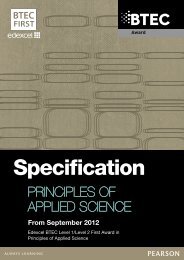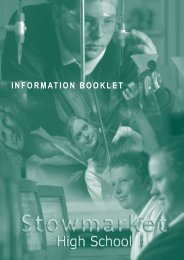BTEC First Award in Application of Science - specification - Edexcel
BTEC First Award in Application of Science - specification - Edexcel
BTEC First Award in Application of Science - specification - Edexcel
You also want an ePaper? Increase the reach of your titles
YUMPU automatically turns print PDFs into web optimized ePapers that Google loves.
UNIT 7: HEALTH APPLICATIONS OF LIFE SCIENCE<br />
Learn<strong>in</strong>g aim B: Know how preventative measures can be used to support<br />
healthy liv<strong>in</strong>g<br />
Learn<strong>in</strong>g aim B requires learners to further their study <strong>of</strong> the immune system. This<br />
should lead on to consideration <strong>of</strong> immunisation programmes. The controversy over<br />
the MMR vacc<strong>in</strong>e provides a good discussion po<strong>in</strong>t for learners to apply scientific<br />
pr<strong>in</strong>ciples, while tak<strong>in</strong>g <strong>in</strong>to account public perceptions. After a brief <strong>in</strong>troduction<br />
from the teacher, learners should research a selection <strong>of</strong> health screen<strong>in</strong>g<br />
programmes. It is expected that learners should then clearly identify the role that<br />
these programmes have <strong>in</strong> ma<strong>in</strong>ta<strong>in</strong><strong>in</strong>g health.<br />
For 1B.4, 1B.5 and 1B.6, learners need to <strong>in</strong>vestigate and identify the role <strong>of</strong> the<br />
immune system, vacc<strong>in</strong>ations and screen<strong>in</strong>g programmes <strong>in</strong> relation to the content<br />
sections B.1 and B.2.<br />
For 2B.4, 2B.P5 and 2B.P6, this needs to be extended to descriptions <strong>of</strong> the role <strong>of</strong><br />
screen<strong>in</strong>g, the immune system and how it defends the body, and the effects <strong>of</strong><br />
vacc<strong>in</strong>ations on the human body.<br />
For 2B.M3 and 2B.M4, learners need to develop their understand<strong>in</strong>g further by<br />
compar<strong>in</strong>g specific and non-specific immune responses, physical barriers<br />
and chemical defences. Vacc<strong>in</strong>es should be expla<strong>in</strong>ed <strong>in</strong> order to identify the changes<br />
that result <strong>in</strong> the body follow<strong>in</strong>g vacc<strong>in</strong>ation. Learners need to discuss health<br />
screen<strong>in</strong>g programmes as <strong>in</strong> content B.2, <strong>in</strong> the context <strong>of</strong> their advantages and<br />
disadvantages. This could be done <strong>in</strong> the form <strong>of</strong> a report or table.<br />
2B.D4 should allow learners to evaluate the effectiveness <strong>of</strong> vacc<strong>in</strong>ation and<br />
screen<strong>in</strong>g programmes. Learners should evaluate at least three <strong>of</strong> the screen<strong>in</strong>g<br />
programmes identified <strong>in</strong> the learn<strong>in</strong>g aim.<br />
Learn<strong>in</strong>g aim C: Investigate how some treatments are used when illness<br />
occurs<br />
For 1.C7, 1C.8, 1C.9 and 2C.P7, 2C.P8 and 2C.P9, learners should consider some<br />
treatments that are available when the body ceases to be healthy. Learners should<br />
understand standard guidel<strong>in</strong>es on treatment regimes and guidance to complete the<br />
course <strong>of</strong> antibiotics. When practical work is undertaken, health and safety issues<br />
relat<strong>in</strong>g to laboratory work <strong>in</strong> the centre or workplace must be emphasised. Risk<br />
assessments, the use <strong>of</strong> COSHH and other regulations <strong>in</strong> place <strong>in</strong> laboratories must<br />
be followed, and all practical work must be supervised by a teacher or a lab<br />
technician. Witness statements/observation records must be completed as evidence<br />
that practical work has been carried out safely and appropriately.<br />
For 2C.M5, learners could carry out a further <strong>in</strong>vestigation us<strong>in</strong>g the <strong>in</strong>ternet or other<br />
resources. Learners should appreciate that one factor <strong>in</strong>fluenc<strong>in</strong>g the <strong>in</strong>crease <strong>in</strong><br />
hospital-acquired <strong>in</strong>fections is the overuse <strong>of</strong> antibiotics. Learners will need to use<br />
their knowledge <strong>of</strong> genetics to <strong>in</strong>vestigate the role <strong>of</strong> gene therapy as a treatment for<br />
certa<strong>in</strong> conditions and diseases. The effectiveness <strong>of</strong> the treatments covered <strong>in</strong> the<br />
unit content can then be considered.<br />
For 2C.M6, learners need to give a description <strong>of</strong> the pr<strong>in</strong>ciples and uses <strong>of</strong> organ<br />
donation and the methods used to reduce organ rejection.<br />
For 2C.D4, learners should evaluate different types <strong>of</strong> medical treatment <strong>in</strong>vestigated<br />
and justify the choice <strong>of</strong> treatment for different disorders.<br />
For 2C.D5, learners need to <strong>in</strong>vestigate stem cell therapy and evaluate the possible<br />
benefits, <strong>in</strong>clud<strong>in</strong>g current benefits and future potential benefits.<br />
BF029957 – Specification – <strong>Edexcel</strong> <strong>BTEC</strong> Level 1/Level 2 <strong>First</strong> <strong>Award</strong> <strong>in</strong> <strong>Application</strong> <strong>of</strong> <strong>Science</strong> –<br />
Issue 1 – March 2012 © Pearson Education Limited 2012<br />
71








